Items filtered by date: April 2024
Surgical Remedies for Ingrown Toenails
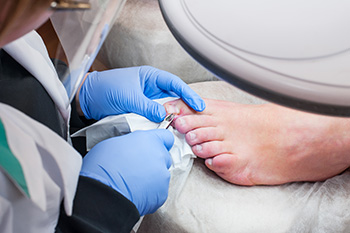
Ingrown toenails occur when the nail grows into the skin of the toe, causing irritation, inflammation, and sometimes infection. Home remedies may provide temporary relief from an ingrown toenail, but if pain persists or signs of infection develop, seeking attention from a podiatrist is important. In such cases, prescription medication and surgical intervention may be necessary. Nail avulsion is a minor procedure that involves removing the ingrown portion of the nail, or the entire nail plate, under local anesthesia. Partial nail avulsion allows for regrowth within months, while complete nail avulsion is less common and results in permanent removal. For recurrent cases of ingrown toenails, a matrixectomy may be recommended. This involves removing the nail root to prevent future ingrowth. Various techniques, including chemical, electrosurgical, or surgical methods, are employed based on individual needs. When an infection develops, a podiatrist will prescribe oral antibiotics to clear the bacteria and prevent complications. If you have persistent pain or redness due to an ingrown toenail, it is suggested that you schedule an appointment with a podiatrist for an exam and treatment options.
Ingrown toenails can become painful if they are not treated properly. For more information about ingrown toenails, contact Sarah Urton, DPM of Kitsilano Foot and Ankle Clinic. Our doctor can provide the care you need to keep you pain-free and on your feet.
Ingrown Toenails
Ingrown toenails occur when a toenail grows sideways into the bed of the nail, causing pain, swelling, and possibly infection.
Causes
- Bacterial infections
- Improper nail cutting such as cutting it too short or not straight across
- Trauma to the toe, such as stubbing, which causes the nail to grow back irregularly
- Ill-fitting shoes that bunch the toes too close together
- Genetic predisposition
Prevention
Because ingrown toenails are not something found outside of shoe-wearing cultures, going barefoot as often as possible will decrease the likeliness of developing ingrown toenails. Wearing proper fitting shoes and using proper cutting techniques will also help decrease your risk of developing ingrown toenails.
Treatment
Ingrown toenails are a very treatable foot condition. In minor cases, soaking the affected area in salt or antibacterial soaps will not only help with the ingrown nail itself, but also help prevent any infections from occurring. In more severe cases, surgery is an option. In either case, speaking to your podiatrist about this condition will help you get a better understanding of specific treatment options that are right for you.
If you have any questions please feel free to contact our office located in Vancouver, BC . We offer the newest diagnostic and treatment technologies for all your foot and ankle needs.
Common Foot Problems Among Children
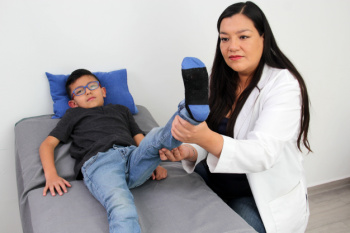
Understanding your child's foot problems is important for early detection and intervention. Sever’s disease, medically known as calcaneal apophysitis, usually affects children ages eight to 14, especially those who are physically active. It is caused by inflammation of the heel growth plate and aggravated by repetitive stress from sports participation. Ingrown toenails in children often result from wearing ill-fitting shoes paired with improper nail cutting. Treatment from a podiatrist and proper shoe fitting changes may be necessary. Intoeing, characterized by walking with inward-turned feet, may require stretching exercises or casting under the guidance of a podiatrist. Metatarsus adductus is a congenital foot deformity that causes the front half of the foot, or forefoot, to turn inward, but typically resolves itself without treatment. However, regular visits to a podiatrist for monitoring are suggested. Pediatric flat feet, while common in babies and toddlers, may warrant intervention to ensure proper arch development if the arch fails to appear with growth. Plantar warts, caused by the human papillomavirus, or HPV, can be painful and affect mobility. If your child has any of these conditions, it is suggested that you schedule an appointment with a podiatrist for periodic exams and treatment as needed.
Making sure that your children maintain good foot health is very important as they grow. If you have any questions, contact Sarah Urton, DPM of Kitsilano Foot and Ankle Clinic. Our doctor can provide the care you need to keep you pain-free and on your feet.
Keeping Children's Feet Healthy
Having healthy feet during childhood can help prevent medical problems later in life, namely in the back and legs. As children grow, their feet require different types of care. Here are some things to consider...
Although babies do not walk yet, it is still very important to take care of their feet.
Avoid putting tight shoes or socks on his or her feet.
Allow the baby to stretch and kick his or her feet to feel comfortable.
As a toddler, kids are now on the move and begin to develop differently. At this age, toddlers are getting a feel for walking, so don’t be alarmed if your toddler is unsteady or ‘walks funny’.
As your child gets older, it is important to teach them how to take care of their feet.
Show them proper hygiene to prevent infections such as fungus.
Be watchful for any pain or injury.
Have all injuries checked by a doctor as soon as possible.
Comfortable, protective shoes should always be worn, especially at play.
If you have any questions please feel free to contact our office located in Vancouver, BC . We offer the newest diagnostic and treatment technologies for all your foot and ankle needs.
Causes and Treatment of an Achilles Tendon Injury
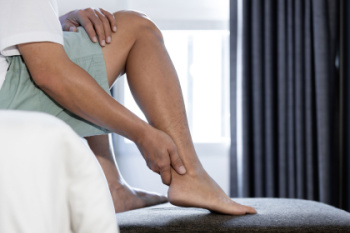
Achilles tendon injuries are common for both athletes and occasional exercisers, presenting significant challenges due to the tendon's pivotal role in mobility. Often triggered by overuse, athletes may push their limits too quickly or neglect proper stretching before physical activity. Also, factors like wearing high heels or foot issues like flat feet can heighten the risk of an Achilles tendon injury. Symptoms typically include pain along the back of the foot and above the heel, and can be worsened by ankle stretching or toe-standing. Diagnosis involves a thorough physical examination by a podiatrist, who also may order imaging tests like an ultrasound or MRI scans to assess the extent of damage. Treatment options vary based on severity and may include prescribing anti-inflammatory medication or certain exercises for rehabilitation. In severe cases or complete tears, surgery may be necessary for tendon repair. If you have injured your Achilles tendon, it is suggested that you schedule an appointment with a podiatrist for a full exam, diagnosis, and suggested treatment plan.
Achilles tendon injuries need immediate attention to avoid future complications. If you have any concerns, contact Sarah Urton, DPM of Kitsilano Foot and Ankle Clinic. Our doctor can provide the care you need to keep you pain-free and on your feet.
What Is the Achilles Tendon?
The Achilles tendon is a tendon that connects the lower leg muscles and calf to the heel of the foot. It is the strongest tendon in the human body and is essential for making movement possible. Because this tendon is such an integral part of the body, any injuries to it can create immense difficulties and should immediately be presented to a doctor.
What Are the Symptoms of an Achilles Tendon Injury?
There are various types of injuries that can affect the Achilles tendon. The two most common injuries are Achilles tendinitis and ruptures of the tendon.
Achilles Tendinitis Symptoms
- Inflammation
- Dull to severe pain
- Increased blood flow to the tendon
- Thickening of the tendon
Rupture Symptoms
- Extreme pain and swelling in the foot
- Total immobility
Treatment and Prevention
Achilles tendon injuries are diagnosed by a thorough physical evaluation, which can include an MRI. Treatment involves rest, physical therapy, and in some cases, surgery. However, various preventative measures can be taken to avoid these injuries, such as:
- Thorough stretching of the tendon before and after exercise
- Strengthening exercises like calf raises, squats, leg curls, leg extensions, leg raises, lunges, and leg presses
If you have any questions please feel free to contact our office located in Vancouver, BC . We offer the newest diagnostic tools and technology to treat your foot and ankle needs.
Treatment for Stiffness in the Big Toe
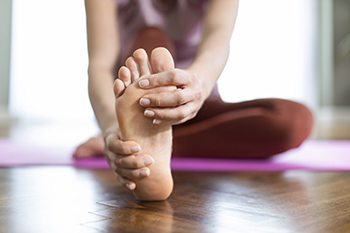
Stiffness in the big toe, medically known as hallux rigidus, usually develops due to arthritis, especially in adults between 30 and 60 years old. This stiffness in the big toe is often found to be the result of past sports injuries. Symptoms can worsen over time, leading to persistent pain, difficulty in wearing shoes, and changes in the way you walk. Treatment options include non-surgical approaches, such as modifying footwear, adjusting activities, and using medications to manage pain and inflammation. In more severe cases, surgery may be necessary. One option is cheilectomy, where bone spurs are removed to improve joint movement. Another surgical option is arthrodesis, which involves fusing the joint to reduce pain. These procedures aim to alleviate symptoms and improve big toe function. Given the complexity of hallux rigidus, it is suggested that you consult a podiatrist for a thorough evaluation and the appropriate treatment recommendations.
Toe pain can disrupt your daily activities. If you have any concerns, contact Sarah Urton, DPM of Kitsilano Foot and Ankle Clinic. Our doctor can provide the care you need to keep you pain-free and on your feet.
What Causes Toe Pain?
Most severe toe pain is caused due to a sports injury, trauma from dropping something heavy on the toe, or bumping into something rigid. Other problems can develop over time for various reasons.
Toe pain can be caused by one or more ailments. The most common include:
- Trauma
- Sports injury
- Wearing shoes that are too tight
- Arthritis
- Gout
- Corns and calluses
- Hammertoe
- Bunions
- Blisters
- Ingrown toenails
- Sprains
- Fractures (broken bones)
- Dislocations
When to See a Podiatrist
- Severe pain
- Persistent pain that lasts more than a week
- Signs of infection
- Continued swelling
- Pain that prevents walking
Diagnosis
In many cases the cause of toe pain is obvious, but in others, a podiatrist may want to use more advanced methods to determine the problem. These can range from simple visual inspections and sensation tests to X-rays and MRI scans. Prior medical history, family medical history, and any recent physical traumatic events will all be taken into consideration for a proper diagnosis.
Treatment
Treatments for toe pain and injuries vary and may include shoe inserts, padding, taping, medicines, injections, and in some cases, surgery. If you believe that you have broken a toe, please see a podiatrist as soon as possible.
If you have any questions please feel free to contact our office located in Vancouver, BC . We offer the newest diagnostic tools and technology to treat your foot and ankle needs.
Heel Pain Can Be Treated!
Managing Blisters on the Feet
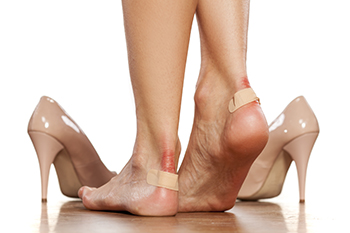
Blisters are small fluid-filled pockets that commonly form on the skin and can be particularly bothersome when they develop on the feet. Whether caused by friction from wearing ill-fitting shoes, prolonged walking, running, or heat, blisters can cause discomfort and interfere with daily activities. While most blisters on the feet heal naturally within a week, it is essential to avoid popping them yourself, as this can increase the risk of infection and prolong recovery time. Instead, gently cover the blister with a dry, sterile dressing to help protect it as it heals. If there are signs of infection, such as redness, swelling, or pus, seeking prompt medical attention from a podiatrist is suggested. Podiatrists may prescribe antibiotics for infected blisters or perform procedures like blister drainage under sterile conditions for larger or more painful blisters. If you experience persistent or recurrent blisters on your feet, it is suggested that you schedule an appointment with a podiatrist to ensure safe and effective treatment as well as prevention strategies.
Blisters may appear as a single bubble or in a cluster. They can cause a lot of pain and may be filled with pus, blood, or watery serum. If your feet are hurting, contact Sarah Urton, DPM of Kitsilano Foot and Ankle Clinic. Our doctor can provide the care you need to keep you pain-free and on your feet.
Foot Blisters
Foot blisters are often the result of friction. This happens due to the constant rubbing from shoes, which can lead to pain.
What Are Foot Blisters?
A foot blister is a small fluid-filled pocket that forms on the upper-most layer of the skin. Blisters are filled with clear fluid and can lead to blood drainage or pus if the area becomes infected.
Symptoms
(Blister symptoms may vary depending on what is causing them)
- Bubble of skin filled with fluid
- Redness
- Moderate to severe pain
- Itching
Prevention & Treatment
In order to prevent blisters, you should be sure to wear comfortable shoes with socks that cushion your feet and absorb sweat. Breaking a blister open may increase your chances of developing an infection. However, if your blister breaks, you should wash the area with soap and water immediately and then apply a bandage to the affected area. If your blisters cause severe pain it is important that you call your podiatrist right away.
If you have any questions, please feel free to contact our office located in Vancouver, BC . We offer the newest diagnostic and treatment technologies for all your foot care needs.

